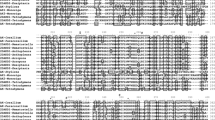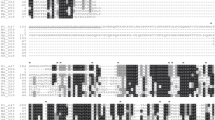Abstract.
Two distinct forms of the highly conserved uracil-DNA glycosylase (UNG) have been isolated from Atlantic cod (Gadus morhua) liver cDNA by rapid amplification of cDNA ends (RACE). From the cDNA sequences, both forms were deduced to encode an open reading frame of 301 amino acids, with an identical 267-amino-acid C-terminal region and different N-terminal regions of 34 amino acids. By comparison with the human UNG sequences, the two forms were identified as possible mitochondrial (cUNG1) and nuclear (cUNG2) forms. Several constructs of recombinant cUNG (rcUNG) were expressed in Escherichia coli in order to optimize the yield. The recombinant enzyme was purified to apparent homogeneity as determined by sodium dodecyl sulfate-polyacrylamide gel electrophoresis. Activity and stability experiments showed that rcUNG was similar to cUNG previously purified from Atlantic cod liver, and was more pH- and temperature labile than a recombinant human UNG (rhUNG). Under optimal assay conditions for both rcUNG and rhUNG, the turnover number (kcat) was three times higher for rcUNG compared with rhUNG, with an identical KM, resulting in a threefold higher catalytic efficiency (kcat/KM) for rcUNG. These activity and stability experiments reveal cold-adapted features in rcUNG. Homology models of the catalytic domains of Atlantic cod (cUNG) and mouse uracil-DNA glycosylase (mUNG) were built using the human UNG (hUNG) crystal structure as a template. The unique amino acid substitutions observed in cod UNG were mainly located in the N- and C-terminal parts of the sequence. The analysis indicated a more stable N-terminal, a more flexible C-terminal, and a less stabilized core in cUNG as compared with the mammalian UNGs. Substitution of several amino acids in or near the DNA-binding site in cUNG could give rise to a more positively charged surface and a higher electrostatic potential near the active site compared with the mammalian UNGs. The higher potential may increase the electrostatic interactions between the enzyme and DNA, and may explain the increased substrate affinity and, in combination with the higher flexibility, the higher catalytic efficiency observed for rcUNG.
Similar content being viewed by others
Author information
Authors and Affiliations
Additional information
Electronic Publication
Rights and permissions
About this article
Cite this article
Lanes, O., Leiros, I., Smalås, A.O. et al. Identification, cloning, and expression of uracil-DNA glycosylase from Atlantic cod (Gadus morhua): characterization and homology modeling of the cold-active catalytic domain. Extremophiles 6, 73–86 (2002). https://doi.org/10.1007/s007920100225
Received:
Accepted:
Issue Date:
DOI: https://doi.org/10.1007/s007920100225




